Text & photographs by
Dr. Mahadeswara Swamy, Scientist
Mob: 97429-91057 e-mail: [email protected]
La Gardenia – A paradise of fruit plants
A garden is an outdoor space for cultivation, display and deriving pleasure and enjoyment of plants and other forms of nature. The most common type of garden is a residential garden built around the living place often designated as ornamental, vegetable or mixed on functional basis. While most of the garden types are a result of a particular local climate or landscape, a few gardens are specialised involving different kinds of plants sourced from diverse climatic regions and acclimatised to local weather in mixed plantings.
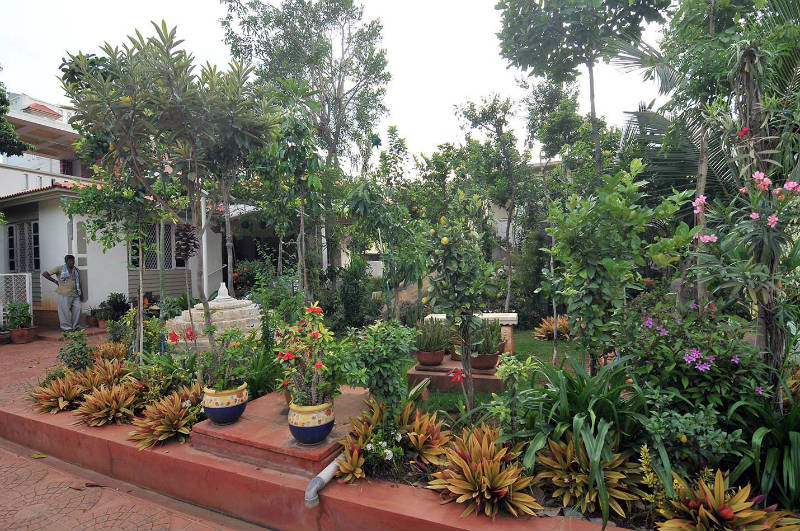
As you enter ‘Santrupti’…
The garden at ‘Santrupti’ in Srirampura, falls into this category. The garden in an area of 120’ x 80’ plot of land with a house in the middle, encompasses matchless combination of ornamental, vegetable and fruit plants beyond one’s imagination. It is a unique type of garden developed by Dr. C.N. Mruthyunjayappa-Sudha couple with germplasms (genetic resources) of innumerable varieties of native and exotic plants from various parts of the world (USA, South America, Britain, Switzerland, Australia, New Zealand, China, Thailand, Malaysia, Africa, Madagascar etc.,) planted therein. It is an amazing home garden-cum-orchard. It can also be called a conservatory of fruit plants sans greenhouse and an open pomology (fruit plant science) laboratory.
The couple claim that the garden houses around 300 varieties of plants which include around 200 varieties of fruit-bearing plants apart from ornamental and vegetable plants. They have travelled across the globe, nook and corners of India to collect these germplasms – a herculean effort by the couple in collecting and nursing these plants.
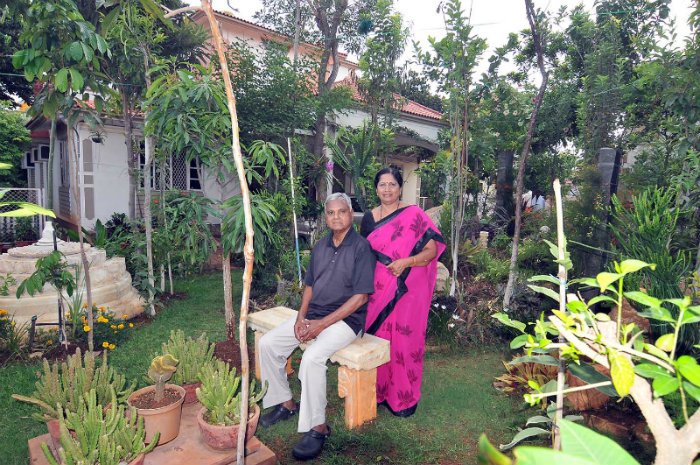
Dr. C.N. Mruthyunjayappa-Sudha couple at their home-garden ‘Santrupti.
Recognising their outstanding contribution in conservation and sharing of Germplasm (fruits and other crops), Government of India (Ministry of Plant Varieties and Farmer’s Rights Authority, New Delhi), has awarded “Plant Genome Saviours Farmer Reward 2015” to Dr. Mruthyunjayappa. He is the second recipient of the Reward from Karnataka ever since it was instituted in 2012. Award is not only a golden feather in the cap of Dr. Mruthyunjayappa-Sudha couple, but also a proud moment for the people of Karnataka in general and Mysuru in particular.
ABOUT THE GARDEN
The garden is aesthetically designed with the front gate opening into a big path way leading to the entrance of the house decorated with exotic climbers on trellis, orchids in hanging pots and colourful lilies on the ground flaunting their gorgeous blooms. The front yard, overlooking the house, adorn the choicest herbs, shrubs and climbers (ornamental, vegetable and fruit) interspersed with trees of various kinds. It includes beautiful climbers like Jade, Mysore clock vine apart from exotic Chestnut, yellow Cassia, holy Himalayan Rudraksha, Sandalwood, Champaka (Magnolia species), Jackfruit trees, Buddha’s hand, Madalambica, Thailand Guava (fruits weighing 3 kg), a special variety of Jasmine bush, Euphorbia milii, and other kinds of plants in pots or on ground.

Exotic fig variety; Another side of ‘Santrupti’; Beehive ginger (Botanical name: Zingiber spectabile).
The back yard and the adjoining areas of the house make up most of the garden. This is the prime area and focal point housing most of the plant taxa largely consisting of trees. The shrubs, climbers and herbs form the under storey and blend harmoniously with the tree flora. There is also a pond full of water lilies in various hues and lots of fish moving around flexing their tail back and forth.
A few honey boxes find a place to encourage cross pollination. This area is a home to variety of fruit plants. The centre of attraction is the mango tree with 100 varieties grafted on to a local variety. One can find varieties of fruit trees, most of them grafted: Citrus fruits (25 varieties include musumbe, orange, pomelo and lemon besides a Switzerland lime (red inside), Sapota (4 varieties), Gauva (12 varieties), Jack fruit (10 varieties with one gum-less variety from Madagascar), Pomegranates (6 varieties), Sitaphal, Ramphal and Hanuman phal (all in one plant).

Madalambica; Gumless Jackfruit; Monstera Deliciosa (Common names: Mexican pineapple, Swiss cheese plant and fruit salad plant); 100 varieties grafted Mango tree.
There are special kinds of exotic fruit plants unheard-of by most people in Mysuru. To mention a few:
- Buddha’s hand, a “Lemon with fingers” — this strange citrus is treasured for its sweet floral fragrance and mild zest. There is little or no flesh or juice inside.
- Miracle berry, a fruit that tricks the tongue causing sour foods to taste sweet.
- Peanut butter tree, the fruits taste similar to peanut butter.
- Kumquats, miniature oval oranges, which have a sour, citrus tang, but peel is sweet and delicious.
- Egg fruit or Canistel, flesh is sweet, with a texture often compared to that of a hard-boiled egg yolk.
- Longsat, an edible fruit looking like litchi.
- Luvia or Seabuckthorn, the holy fruit of the Himalayas, the orange-coloured pearl-shaped clustered berries are tasty and contain an array of essential fatty acids, vitamins and carotenoids.
- Dragon fruit, a cactus plant with large white flowers and a sweet fragrance produces flaming-pink coloured edible fruits (available in local supermarkets).
- Swiss cheese plant or Mexican pine apple, the ripe fruit tastes like a combination of banana, pineapple and mango (Raw fruit is poisonous).
- Rambai or Rambi, which grows wild and cultivated for its sweet-acid flavoured fruit appreciated in part of Southeast Asia in Thailand and Peninsular Malaysia besides Amla, Wood Apple, Papaya, Mulberry.
[WRGF id=25812]
However, I did not notice grapes. The other fruit varieties including exotic ones are Apricot, Apple (3 varieties grafted on to one tree), Blackberry, Rose apple (2 varieties), Almond, Sweet Almond (Sakkara badami), Ber, Dates (2 varieties), Mangosteen, Plum, Pistachio, Phalsa, Raspberry, Star cherry, Sweet Tamarind, Kokam, Water apple, Velvet apple besides the rare flowering tree Suragi, special varieties of Drumstick, Agase, Veeranagere brinjal, cherry tomato, hot and sweet chillies, leafy herbs like Mysore betel leaves (2 varieties), mint and many more. The list is endless. I understand the garden is fully organic using only animal manure. No chemical pesticide or fertiliser is applied. Furthermore, the fruits are not harvested by and large but left on the trees for birds which hover around the garden.
In my judgment, the garden duo, blessed with green thumb, have not only mastered the techniques of raising any type of garden plants but also the art of grafting. The super-specialist grafter in him, Dr. Mruthyunjayappa can skilfully trim or graft any plant using fitting tools — not an easy job (horticulturists included). The proof lies in the fact that deft hands of the medical doctor have made surgical correction to most of the trees either in the form of graft or shaping them to uni-branch trees.
When I asked the difficult plant to graft, he said it is ‘Gauva.’ Soon after, I left the place fearing the Doctor might graft a plant part on to my body. For me the visit was a learning experience.
With an array of fruits-n-nuts and other plant life in it, the garden at ‘Santrupti’ is not only a home garden but a knowledge house. A must visit for the researchers and students of Agri-horticulture and Botany. For the plant enthusiast, it is worth emulating the duo’s quest for planting more and more new plants and expanding their knowledge on garden techniques every day.
BRIEF BIOGRAPHY
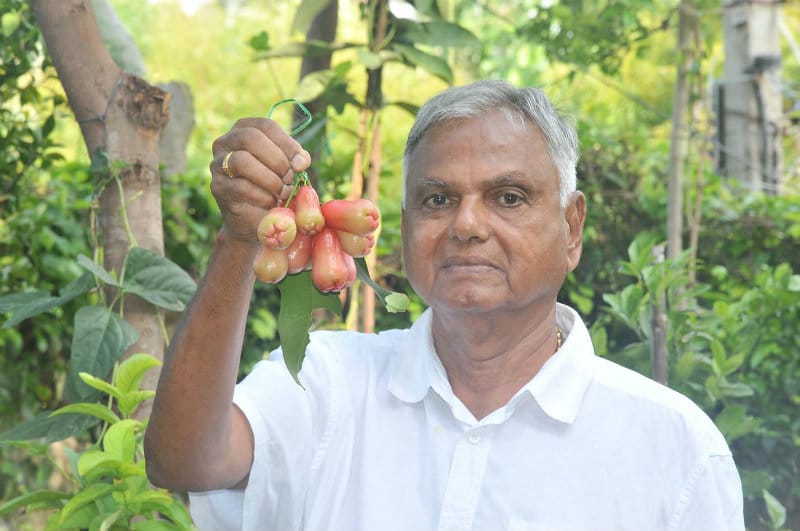
Dr. Mruthunjayappa displaying Syzygium samarangense (Common names: Wax apple, love apple, java apple, royal apple, bell fruit (or bellfruit), Jamaican apple, water apple).
Dr. Mruthunjayappa is a doctor (MBBS) by profession with a Bachelor’s degree in B.Sc (Botany) as well. The medical practitioner started the clinic in Sargur, the most backward area in H.D. Kote taluk and served the people for more than 35 years and later shifted to Mysuru. He also served as a Medical Superintendent of JSS Hospital, Mysuru, for a short period. He is also an environmentalist and philanthropist. During his medical career at Sargur, he treated poor patients free of cost and also constructed dwelling houses for his subordinate staff as owners. He is a Trustee / Member in many social service organisations. In Sargur he started ‘Vanasiri’ Trust (Founder-President) devoted for afforestation and wild life protection and was responsible for creating tree belts around Sargur. After shifting to Mysore (Srirampura), he is responsible for planting many trees in the locality. He received Vaidyarathna award (2011) for his outstanding services as a medical doctor. His hobby is gardening and travelling abroad. His wife Sudha is a Science graduate and joins hands in all the activities of the doctor. The philanthropist couple have donated generously to many organisations involved in social cause. Very recently, they donated the entire prize money (Genome Saviour Reward, 2015) to a poor farmer (Rs. 1 lakh) and a social organisation (Rs. 0.5 lakh).
Dr. Mruthunjayappa resides at #72, ‘Santrupti,’ Shantala Marga, Srirampura, Mysuru-570008



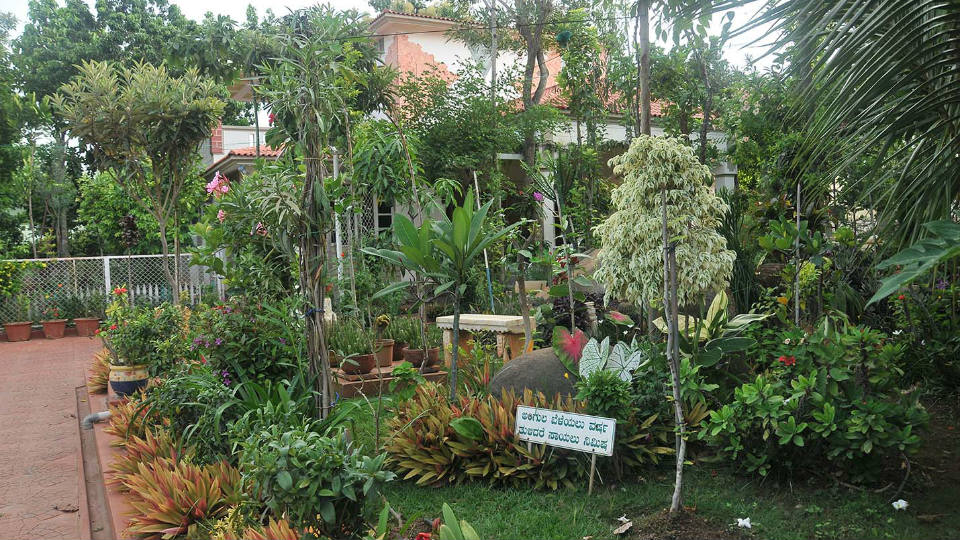
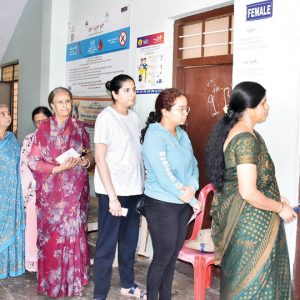
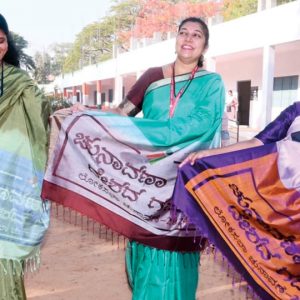


I wish to visit the garden to see the plantation,as reading about it is exciting and perhaps seeing could be fascinating
Can I have contact details of dr M
The article in DH offers an exciting reading, so I wish to visit the garden Santorini to see how fascinating it cud be to see the varieties
I also hv a small garden in mysuru
Pl furnish your contact details
Sastry